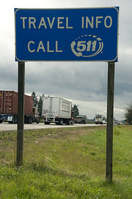Regional 511 could help riders amid patchwork of agencies

Photo by OregonDOT on Flickr.
A natural disaster or man-made crisis could snarl traffic and disrupt bus and rail routes. Even transit riders who have planned a backup route might find it disrupted as well. Travelers could better deal with disruptions if they could get information for multiple agencies and modes at the same time.
The DC metropolitan area is served by many modes of transportation, which are provided by an equally large number of agencies. Yet there’s no single, integrated source of information. Getting information on disruptions is harder than it needs to be, and it’s hard to find information on alternatives.
Every agency has its own contact information; some publish real-time information online, and some don’t. A single source for transit information, available over the phone, by text message, on the Web, and on Twitter and social media, makes transit more accessible and more usable.
WMATA may be the largest transit agency in the area, but it’s far from being the only one; many riders make their daily commute using bus service provided by agencies like Montgomery County Ride On and Fairfax Connector, while others use MARC and VRE commuter rail. For commuters who ride a bus or drive, road conditions are also a factor.
Several large metropolitan areas have created single, regional points of contact for transit and travel information through the 511 telephone number. Some of the best include the San Francisco Bay Area, Los Angeles, and New York.
511 services are designed to provide transit and travel information across agencies and modes of transportation. While 511 systems were originally envisioned to provide information by phone, many have expanded to serve as a single source for transit and travel information online, over text messaging, on Twitter, and on Facebook and other social media.
A 511 system in the DC area could give travelers information on road conditions, bus and rail service, and even carpooling and bikesharing, all without requiring them to remember which agencies operate which services, or how to get in touch with each particular agency.
Such a system would have to reach out from DC into Northern Virginia and Maryland. VDOT currently operates a 511 system for Virginia, but it’s principally focused on road conditions. By creating a single regional system, transit riders and commuters would be able to access the same transit and travel information no matter where they are in the region.
In order to achieve this, the system would have to be operated at the regional level, either by a group like the Metropolitan Washington Council of Governments, or a new coalition of DOTs and transit agencies created for the purpose of operating the 511 system.
These systems aren’t cheap; estimates from the U.S. Department of Transportation show that 511 systems cost between $500,000 and $1 million to implement, but the return on investment is substantial. The DOT study found that 511 systems, on average, have high levels of customer satisfaction, and the information they provide helps to encourage travelers and commuters to consider transit alternatives, reducing congestion and travel times.
A regional 511 system would also give smaller transit operations an opportunity to make real-time information available. A transit agency without its own real-time information system, like Montgomery County Ride On, would be able to log in to the regional 511 system and enter service status messages. This information would then be instantly available over the phone, on the Web, by text message, and through other channels (such as electronic displays at bus stops and transit centers). Yet, by being part of a regionally-integrated system, these agencies would have little infrastructure of their own to maintain.
WMATA’s new Director of Communications, Dan Stessel, has pledged to improve information for bus riders by hiring staff to issue text alerts using the same system currently used for rail alerts. Text alerts are a great step, but not everyone can use them. WMATA’s information line isn’t available late at night, but 511 systems offer information 24/7.
A regional 511 system would offer information on all of the area’s transit systems, along with information on road conditions, bikesharing, carpooling, and more, and make it available through a wide variety of channels, reaching the greatest possible number of transit users and travelers.
